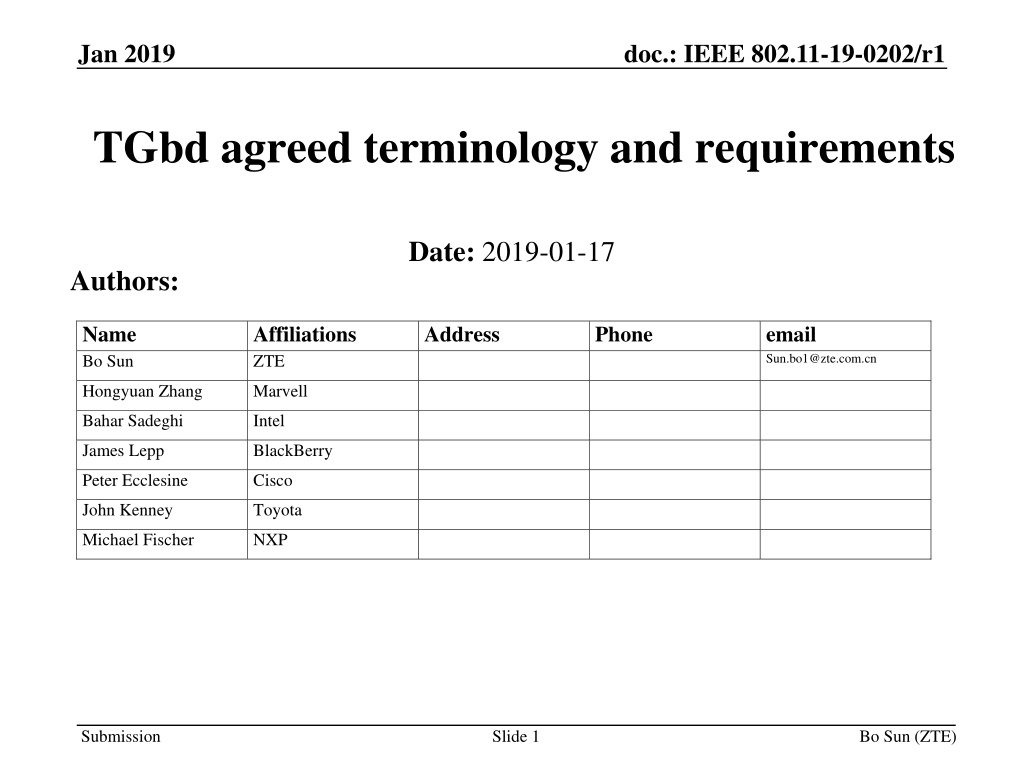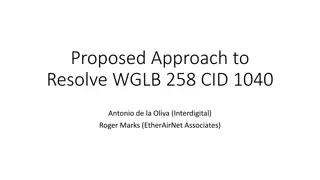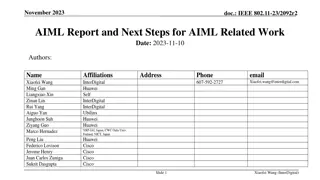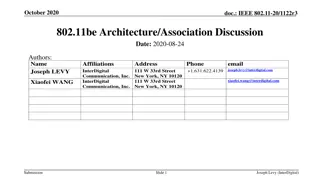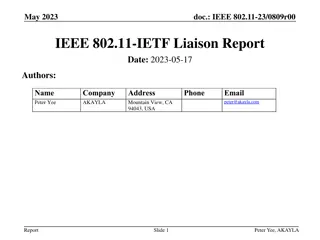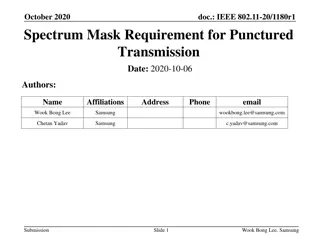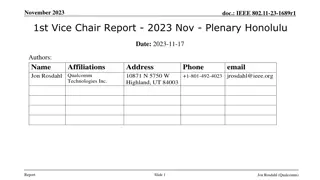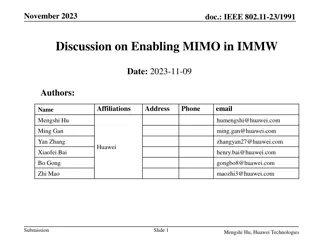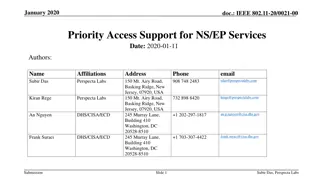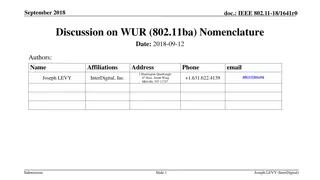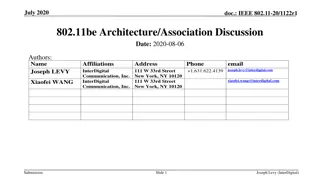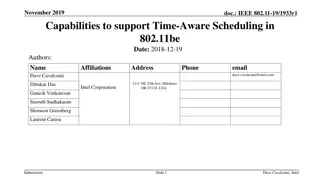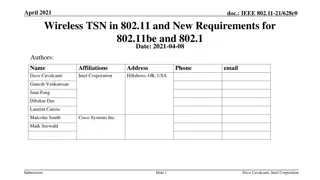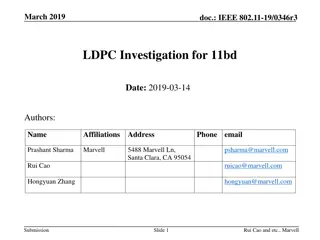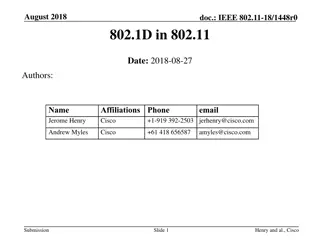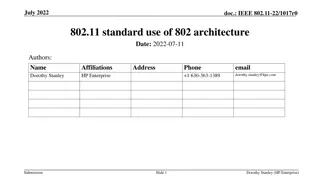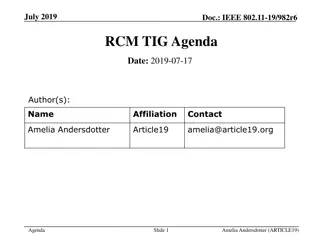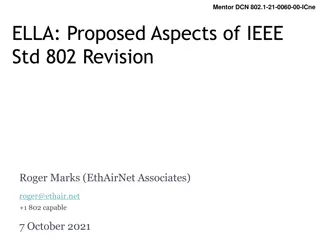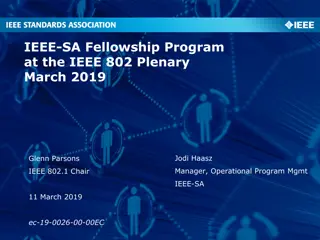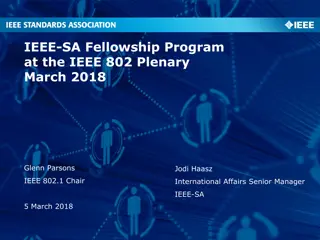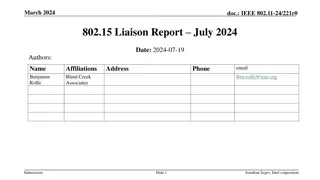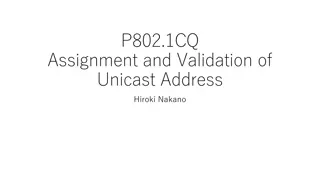IEEE 802.11-19-0202/r1 TGbd Agreed Terminology and Requirements
This document outlines the agreed terminology and requirements for the development of the next generation of IEEE 802.11p technology within IEEE 802.11bd Task Group. It covers aspects such as interoperability, co-existence, backward compatibility, and fairness between IEEE 802.11p and IEEE 802.11bd devices, ensuring smooth operation and communication. References to related IEEE standards are also provided.
Download Presentation

Please find below an Image/Link to download the presentation.
The content on the website is provided AS IS for your information and personal use only. It may not be sold, licensed, or shared on other websites without obtaining consent from the author. Download presentation by click this link. If you encounter any issues during the download, it is possible that the publisher has removed the file from their server.
E N D
Presentation Transcript
Jan 2019 doc.: IEEE 802.11-19-0202/r1 TGbd agreed terminology and requirements Date: 2019-01-17 Authors: Name Bo Sun Affiliations ZTE Address Phone email Sun.bo1@zte.com.cn Hongyuan Zhang Marvell Bahar Sadeghi Intel James Lepp BlackBerry Peter Ecclesine Cisco John Kenney Toyota Michael Fischer NXP Submission Slide 1 Bo Sun (ZTE)
Jan 2019 doc.: IEEE 802.11-19-0202/r1 Abstract This document contains the agreed terminology to be used in the development of the next generation of IEEE 802.11p technology in IEEE 802.11bd Task Group [1] It also reiterates the PAR requirements related to the agreed terminology [2] Submission Slide 2 Bo Sun (ZTE)
Jan 2019 doc.: IEEE 802.11-19-0202/r1 Terminology Interoperability IEEE 802.11p devices to be able to decode at least one mode of transmission of IEEE 802.11bd devices, and IEEE 802.11bd devices to be able to decode IEEE 802.11p transmissions Co-existence IEEE 802.11p devices to be able to detect IEEE 802.11bd transmissions (and hence defer from transmissions during IEEE 802.11bd transmissions causing collisions) and vice versa Backward compatibility Ability of IEEE 802.11bd devices to operate in a mode in which they can interoperate with IEEE 802.11p devices Fairness Ability of IEEE 802.11p devices to have the same opportunities as IEEE 802.11bd devices to access the channel Submission Slide 3 Bo Sun (ZTE)
Jan 2019 doc.: IEEE 802.11-19-0202/r1 IEEE 802.11bd Device Modes Mode transition (backward compatibility) TX: New PHY TX: 11p messages RX: Both 11bd and 11p messages 11p device is aware of messages but can t decode (coexistence) 11p device decodes messages (interoperate) Submission Slide 4 Bo Sun (ZTE)
Jan 2019 doc.: IEEE 802.11-19-0202/r1 TGbd Requirement IEEE 802.11bd amendment shall provide interoperability, coexistence, backward compatibility, and fairness with deployed OCB (Outside the Context of a BSS) devices. [2] Outside the Context of a BSS" is the current IEEE 802.11 term that describes wireless communication pursuant to amendment 802.11p In order to support the above requirement An IEEE 802.11bd device transmitting an IEEE 802.11p-conformant frame shall include an indication that it is an IEEE 802.11bd-capable device. IEEE 802.11bd capability indication enables future proof interoperability among different generations of DSRC technology. Submission Slide 5 Bo Sun (ZTE)
Jan 2019 doc.: IEEE 802.11-19-0202/r1 References [1] IEEE 802.11-18/1323r2 NGV SG Use Cases [2] IEEE 802.11-18/0861r9 IEEE 802.11 NGV SG Proposed PAR Submission Slide 6 Bo Sun (ZTE)
